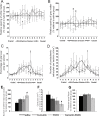Does combined therapy of curcumin and epigallocatechin gallate have a synergistic neuroprotective effect against spinal cord injury?
- PMID: 29451216
- PMCID: PMC5840977
- DOI: 10.4103/1673-5374.224379
Does combined therapy of curcumin and epigallocatechin gallate have a synergistic neuroprotective effect against spinal cord injury?
Abstract
Systematic inflammatory response after spinal cord injury (SCI) is one of the factors leading to lesion development and a profound degree of functional loss. Anti-inflammatory compounds, such as curcumin and epigallocatechin gallate (EGCG) are known for their neuroprotective effects. In this study, we investigated the effect of combined therapy of curcumin and EGCG in a rat model of acute SCI induced by balloon compression. Immediately after SCI, rats received curcumin, EGCG, curcumin + EGCG or saline [daily intraperitoneal doses (curcumin, 6 mg/kg; EGCG 17 mg/kg)] and weekly intramuscular doses (curcumin, 60 mg/kg; EGCG 17 mg/kg)] for 28 days. Rats were evaluated using behavioral tests (the Basso, Beattie, and Bresnahan (BBB) open-field locomotor test, flat beam test). Spinal cord tissue was analyzed using histological methods (Luxol Blue-cresyl violet staining) and immunohistochemistry (anti-glial fibrillary acidic protein, anti-growth associated protein 43). Cytokine levels (interleukin-1β, interleukin-4, interleukin-2, interleukin-6, macrophage inflammatory protein 1-alpha, and RANTES) were measured using Luminex assay. Quantitative polymerase chain reaction was performed to determine the relative expression of genes (Sort1, Fgf2, Irf5, Mrc1, Olig2, Casp3, Gap43, Gfap, Vegf, NfκB, Cntf) related to regenerative processes in injured spinal cord. We found that all treatments displayed significant behavioral recovery, with no obvious synergistic effect after combined therapy of curcumin and ECGC. Curcumin and EGCG alone or in combination increased axonal sprouting, decreased glial scar formation, and altered the levels of macrophage inflammatory protein 1-alpha, interleukin-1β, interleukin-4 and interleukin-6 cytokines. These results imply that although the expected synergistic response of this combined therapy was less obvious, aspects of tissue regeneration and immune responses in severe SCI were evident.
Keywords: curcumin; epigallocatechin gallate; inflammatory response; neural regeneration; spinal cord injury.
Conflict of interest statement
The authors declare that the study was conducted in the absence of any commercial or financial relationships that could be construed as a potential conflict of interest
Figures




Similar articles
-
A green tea polyphenol epigallocatechin-3-gallate enhances neuroregeneration after spinal cord injury by altering levels of inflammatory cytokines.Neuropharmacology. 2017 Nov;126:213-223. doi: 10.1016/j.neuropharm.2017.09.006. Epub 2017 Sep 9. Neuropharmacology. 2017. PMID: 28899730
-
Effect of curcumin on the inflammatory reaction and functional recovery after spinal cord injury in a hyperglycemic rat model.Spine J. 2019 Dec;19(12):2025-2039. doi: 10.1016/j.spinee.2019.07.013. Epub 2019 Aug 14. Spine J. 2019. PMID: 31421247
-
Nano-formulated curcumin (Lipodisq™) modulates the local inflammatory response, reduces glial scar and preserves the white matter after spinal cord injury in rats.Neuropharmacology. 2019 Sep 1;155:54-64. doi: 10.1016/j.neuropharm.2019.05.018. Epub 2019 May 17. Neuropharmacology. 2019. PMID: 31108112
-
Neuroprotective effects of interleukin 10 in spinal cord injury.Front Mol Neurosci. 2023 Jul 10;16:1214294. doi: 10.3389/fnmol.2023.1214294. eCollection 2023. Front Mol Neurosci. 2023. PMID: 37492521 Free PMC article. Review.
-
Role of Curcumin and (-)-Epigallocatechin-3-O-Gallate in Bladder Cancer Treatment: A Review.Cancers (Basel). 2020 Jul 5;12(7):1801. doi: 10.3390/cancers12071801. Cancers (Basel). 2020. PMID: 32635637 Free PMC article. Review.
Cited by
-
The transplantation of human urine stem cells combined with chondroitinase ABC promotes brain-derived neurotrophic factor and nerve growth factor following spinal cord injury in rats.Int J Clin Exp Pathol. 2018 Aug 1;11(8):3858-3866. eCollection 2018. Int J Clin Exp Pathol. 2018. PMID: 31949773 Free PMC article.
-
Epigallocatechin 3-gallate-induced neuroprotection in neurodegenerative diseases: molecular mechanisms and clinical insights.Mol Cell Biochem. 2025 Jun;480(6):3363-3383. doi: 10.1007/s11010-025-05211-4. Epub 2025 Jan 20. Mol Cell Biochem. 2025. PMID: 39832108 Free PMC article. Review.
-
The Role of Green Tea Catechin Epigallocatechin Gallate (EGCG) and Mammalian Target of Rapamycin (mTOR) Inhibitor PP242 (Torkinib) in the Treatment of Spinal Cord Injury.Antioxidants (Basel). 2023 Feb 3;12(2):363. doi: 10.3390/antiox12020363. Antioxidants (Basel). 2023. PMID: 36829922 Free PMC article.
-
New Model of Ventral Spinal Cord Lesion Induced by Balloon Compression in Rats.Biomedicines. 2020 Nov 5;8(11):477. doi: 10.3390/biomedicines8110477. Biomedicines. 2020. PMID: 33167447 Free PMC article.
-
Curcumin/pEGCG-encapsulated nanoparticles enhance spinal cord injury recovery by regulating CD74 to alleviate oxidative stress and inflammation.J Nanobiotechnology. 2024 Oct 24;22(1):653. doi: 10.1186/s12951-024-02916-4. J Nanobiotechnology. 2024. PMID: 39443923 Free PMC article.
References
-
- Alvarez-Perez B, Homs J, Bosch-Mola M, Puig T, Reina F, Verdu E, Boadas-Vaello P. Epigallocatechin-3-gallate treatment reduces thermal hyperalgesia after spinal cord injury by down-regulating RhoA expression in mice. Eur J Pain. 2015;20:341–352. - PubMed
-
- Aydin MS, Caliskan A, Kocarslan A, Kocarslan S, Yildiz A, Gunay S, Savik E, Hazar A, Yalcin F. Intraperitoneal curcumin decreased lung, renal and heart injury in abdominal aorta ischemia/reperfusion model in rat. Int J Surg. 2014;12:601–605. - PubMed
-
- Basso DM, Beattie MS, Bresnahan JC. A sensitive and reliable locomotor rating scale for open field testing in rats. J Neurotrauma. 1995;12:1–21. - PubMed
-
- Bibikova M, Yeakley JM, Chudin E, Chen J, Wickham E, Wang-Rodriguez J, Fan JB. Gene expression profiles in formalin-fixed, paraffin-embedded tissues obtained with a novel assay for microarray analysis. Clin Chem. 2004;50:2384–2386. - PubMed
-
- Carstens E, Ansley D. Hindlimb flexion withdrawal evoked by noxious heat in conscious rats: magnitude measurement of stimulus-response function, suppression by morphine and habituation. J Neurophysiol. 1993;70:621–629. - PubMed
LinkOut - more resources
Full Text Sources
Other Literature Sources
Research Materials
Miscellaneous

